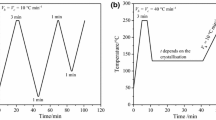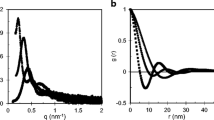Abstract
This paper studies the effect of molecular mass on the melting temperature, enthalpy and entropy of hydroxy-terminated poly(ethylene oxide) (PEO). It aims to correlate the thermal behaviour of PEO polymers and their variation of molecular mass (MW). Samples ranging from 1500 to 200,000 isothermally treated at 373 K during 10 min, were investigated using DSC and Hot Stage Microscopy (HSM). On the basis of DSC and HSM results, melting temperatures were determined, and melting enthalpies and entropies were calculated. Considering the melting temperatures, it was found that the maximum or critical value of MW was found around 4000, and then these remain almost constant. This behaviour was interpreted assuming that lower MW fractions (MW<4000) crystallize in the form of extended chains and higher MW fractions (MW>4000), as folded chains. The melting enthalpies showed a scattering effect at least up to MW 35,000. It was difficult to obtain any relationship between melting enthalpies in J g−1 and MW. These variations seem to be of statistical nature. Corrected enthalpy data on a molar basis (kJ mol−1) exhibited a linear relationship with MW. Considering the solid—liquid equilibrium, the melting entropies (in kJ mol−1) were calculated. These values were more negative as compared with molar enthalpy increases. It was explained because the changes in melting temperatures are much smaller than those observed in the enthalpy values. Linear relationship between enthalpies andentropies as a function of MW was deduced.
Similar content being viewed by others
References
J. P. Arlie, P. A. Spegt and A. E. Skoulios, Makromol. Chem., 99 (1966) 160.
H. Tadokoro, Macromol. Rev., 1 (1966) 119.
D. R. Beech, C. Booth, D. V. Dogson and I. H. Hillier, J. Polym. Sci.: Part A-2, 10 (1972) 1555.
F. E. Bailey and J. V. Koleske, Polyethylene oxide, Academic Press, New York, USA 1976.
Yu. K. Godovsky, G. L. Slonimsky and N. M. Garbar, J. Polym. Sci. Part C, 38 (1972) 1.
M. Mihailov, E. Nedkov and I. Goshev, J. Macromol. Sci. Phys., B15 (1978) 313.
R.C. Allen and L. Mandelkern, J. Polym. Sci. Polym. Phys. Ed., 20 (1982) 1465.
L. Mandelkern, Crystallization of Polymers, McGraw.Hill, New York 1964.
A. J. Kovacs, A. Gonthier and C. Straupe, J. Polym. Sci., 50 (1975) 283.
C. P. Buckley and A. J. Kovacs, Coll. Polym. Sci., 695 (1976) 695.
R. Yang, X. R. Yang, D. F. Evans, W. A. Hendricks and J. Baker, J. Phys. Chem., 94 (1990) 6123.
W. L. Chiou and S. Riegelman, J. Pharm. Sci., 60 (1971) 1281.
J. L. Ford, A. F. Stewart and J. L. Dubois, Int. J. Pharm., 26 (1986) 11.
H. Hommel, A. P. Legrand, P. Tougne, H. Balard and E. Papirer, Macromol., 17 (1984) 1578.
M. L. Green, T. Kramer, M. Parish, J. Fox, R. Lalanandham, W. Rhine, S. Barclay, P. Calvert and H. K. Bowen, Advances in Ceramics Vol. 21, Ceramic Powder Science and Technology, The American Ceramic Society, Westerville, USA 1987.
M. L. Green, W. E. Rhine, P. Calvert and H. K. Bowen, J. Mater. Sci. Lett., 12 (1993) 1425.
Yu. S. Lipatov and C. M. Sergeeva, Adsorption of Polymers, J. Wiley and Sons, New York, USA 1974.
J. Zheng, J. S. Reed and S. K. Verma, Am. Ceram. Soc. Bull., 73 (1994) 61.
M. J. Fraser, D. R. Cooper and C. Booth, Polymer, 18 (1977) 852.
D. Q. M. Craig and J. M. Newton, Int. J. Pharm., 74 (1991) 33.
Y. Kambe, Polymer, 21 (1980) 352.
A. M. Afifj-Effat and J. N. Hay, J. Chem. Soc. Faraday Trans., 2 (1972) 656.
E. Alfthan and A. de Ruvo, Polymer, 16 (1975) 692.
M. Costagliola, R. Greco and A. Martuscelli, Polymer, 19 (1978) 860.
J. L. Ford, Pharm. Acta Helv., 59 (1984) 280.
S. M. Chatham, S. T. P. Pharm., 3 (1987) 575.
P. J. Flory, J. Chem. Phys., 17 (1949) 223.
J. N. Hay, M. Sabir and R. L. T. Steven, Polymer, 10 (1969) 187.
D. R. Beech and C. Booth, Polymer Lett., 8 (1970) 731.
R. H. Beaumont, B. Clegg, G. Gee, J. B. M. Herbert, D. J. Marks, R. C. Roberts and D. Sims, Polymer, 7 (1966) 401.
P. J. Flory and A. Vrij, J. Am. Chem. Soc., 85 (1963) 3548.
M. D. Tuladhar, J. E. Carless and M. P. Summers, J. Pharm. Pharmacol., 35 (1983) 208.
Author information
Authors and Affiliations
Corresponding author
Rights and permissions
About this article
Cite this article
Sánchez-Soto, P.J., Ginés, J.M., Arias, M.J. et al. Effect of Molecular Mass on the Melting Temperature, Enthalpy and Entropy of Hydroxy-Terminated PEO. Journal of Thermal Analysis and Calorimetry 67, 189–197 (2002). https://doi.org/10.1023/A:1013758518721
Issue Date:
DOI: https://doi.org/10.1023/A:1013758518721




